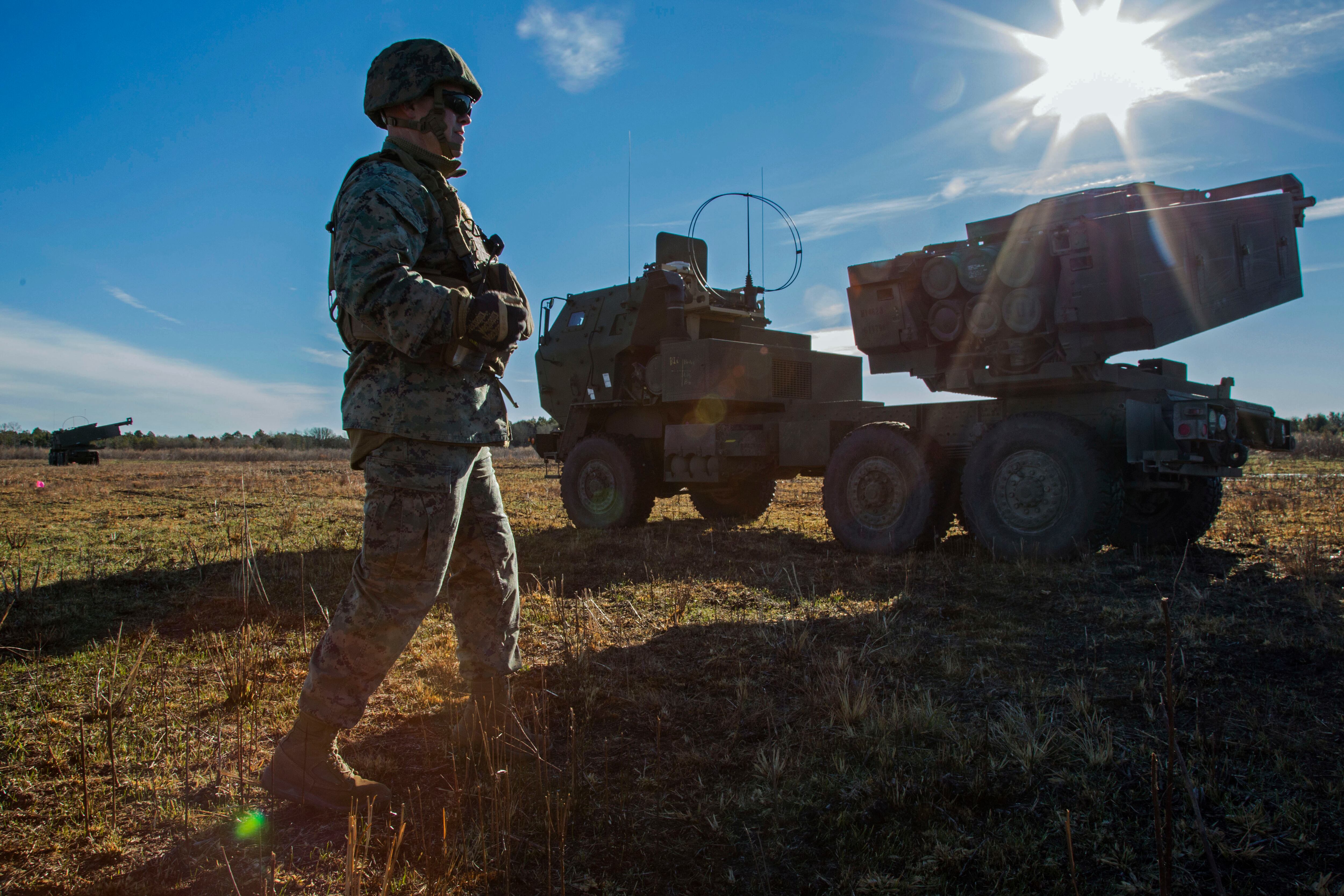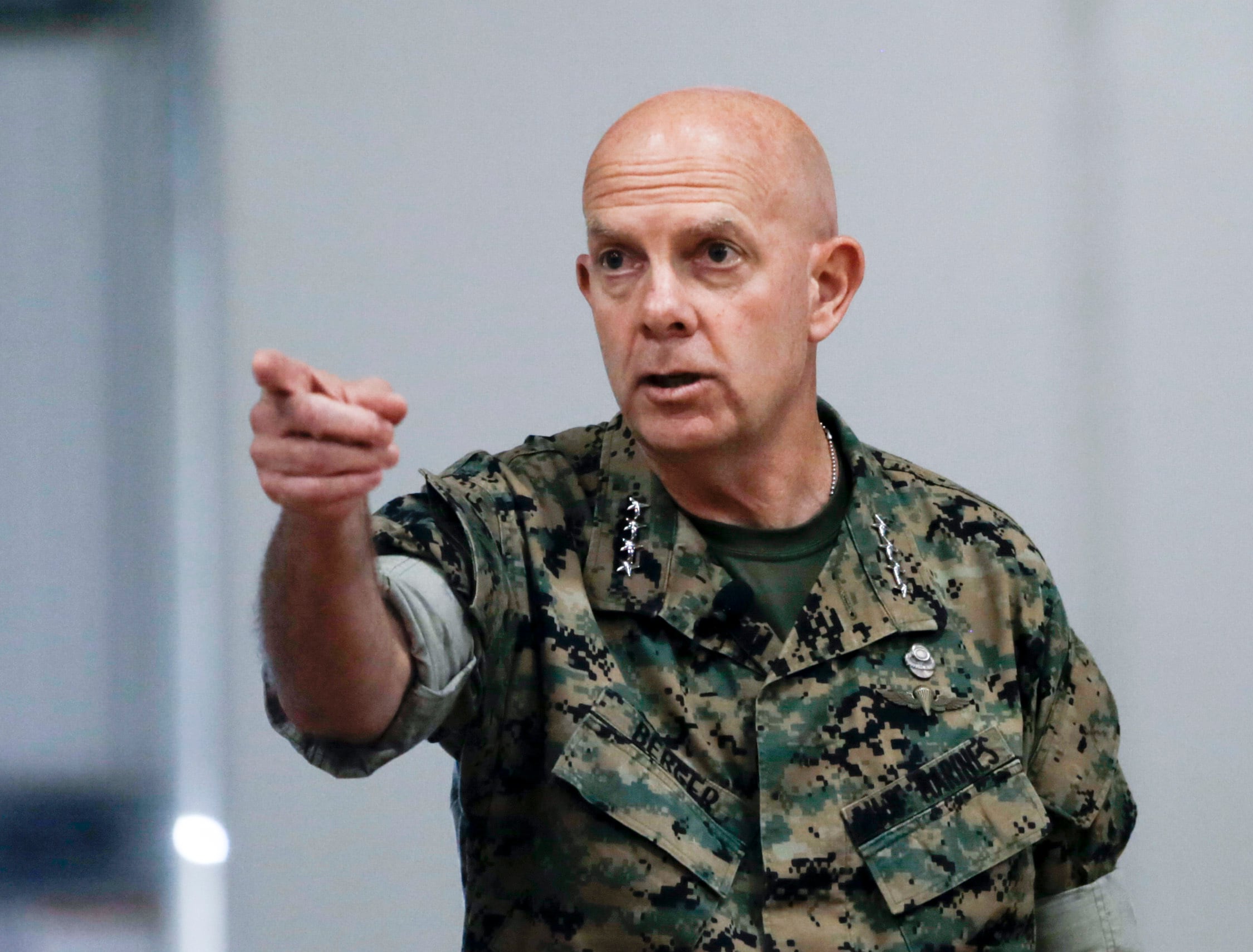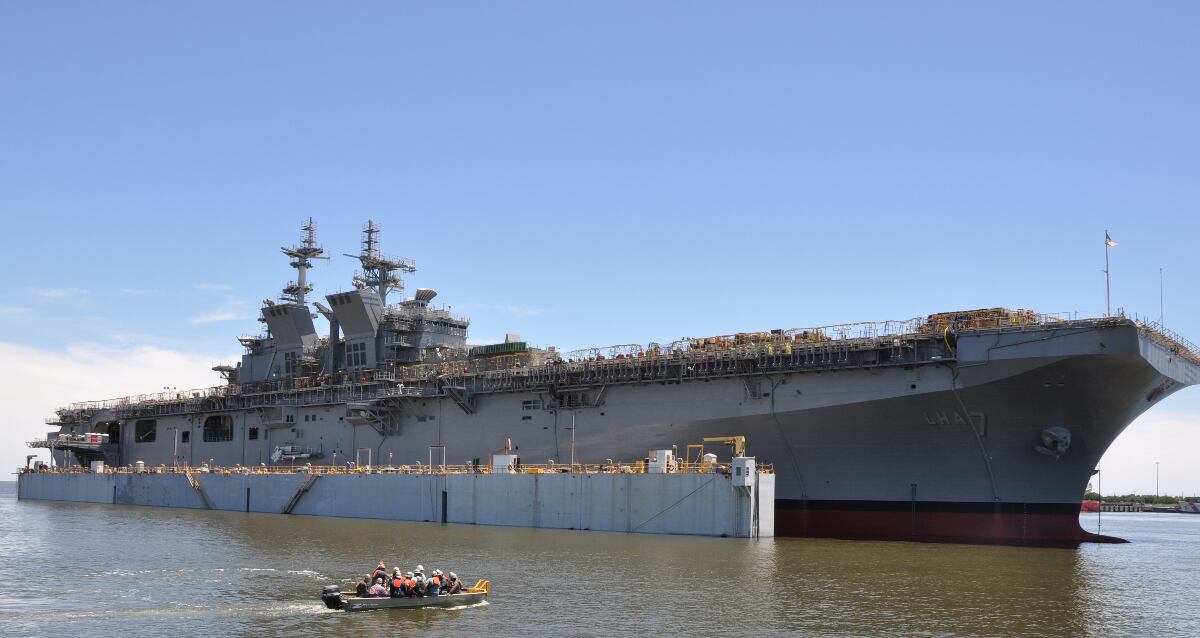WASHINGTON — As the new commandant of the U.S. Marine Corps seeks to make radical changes to how the service operates, there are signs some of the old-guard Marines are dubious of aligning too closely with the Navy.
In a scathing op-ed in The National Interest, former senator and Navy Secretary Jim Webb, who served as a Marine in Vietnam, blasted Gen. David Berger’s plan — described in his planning guidance issued last summer — as too narrowly focused on a single mission: raids on islands in the South China and East China seas.
But in response to a question on Webb’s op-ed at a small roundtable of reporters, Berger rejected the criticism, saying that while he welcomes “informed debate,” the Marines must pace the China threat and that any force designed to take on China would be applicable all over the globe.
RELATED

“Any informed debate is always helpful when you are going through a refocusing of your force,” Berger said. “I welcome the criticism, as long as it is informed. The central role of the Marine Corps is to be a [ready force]; the 9-1-1 force; the force that has to be the most ready when the Nation is least ready. That has not, and will not, change.
“That said, we have threats now on the horizon that we need to prepare for, or we will be overmatched and we won’t allow that to happen.”
While Berger defended his plan, the editorial from such a respected Marine alumnus raises the possibility of deeper cultural resistance to some of the sweeping changes the commandant is proposing. But several experts who spoke with Defense News said that Berger’s reorientation of the force was overdue and that resistance aside, the Marine Corps has no choice but to adapt to an adversary with a robust array of guided munitions.
To be sure, cuts such as the reduction from 24 infantry battalions to 21 slightly smaller infantry battalions, elimination of nearly all artillery batteries in exchange for a boom in rocket and missile batteries, and the complete elimination of tanks from the Marine Corps would fundamentally reshape the force.
In his editorial, Webb called out proposed cuts to field artillery and tanks, as well as cuts to infantry and reserve strength, and corresponding cuts to aviation, as permanent and potentially dangerous.
“The proposal was based on extensive wargaming, in which the new Commandant has great confidence,” Webb wrote. “But it is axiomatic that experimental war games (like staff studies) can be biased through subtle control of the methodology decided upon by those who design the war game.
“There is no greater danger in military strategy than shaping a nation’s force structure to respond to one specific set of contingencies, giving an adversary the ability to adjust and adapt beforehand. Nor would it serve the country’s long-term interests for the Marine Corps to careen from two decades of overemphasis in the Middle East to a fixation with narrow naval scenarios in places like the South China Sea.”
But Berger vehemently disagreed with Webb’s conclusion that his guidance would leave the force too narrowly focused.

“Are we too narrowly focused? I would argue absolutely not,” Berger said. “We’re pacing, in terms of capability, against a very rapidly developing adversary so that we’re never overmatched.
“But that’s not geographically constrained; that’s not nationally constrained. The Navy and Marine Corps operates around the world and I am very confident that will continue. The force that we end up with, you can apply that force to any mission set. It will be very capable.”
Subordinate service?
Underpinning much of Webb’s criticism is the notion that the Marine Corps would lose its identity as a separate service and would again become a subordinate service of the Navy, tied to the Navy’s requirements.
Berger’s plan “could permanently reduce the long-standing mission of global readiness that for more than a century has been the essential reason for its existence as a separate service,” Webb wrote. “Its long-term impact would undo the value of the Marine Corps as the one-stop guarantor of a homogeneous tactical readiness that can ‘go anywhere, fight anybody, and win.’
“And after the centuries it took to establish the Marine Corps as a fully separate military service, it could reduce its present role by making it again subordinate to the funding and operational requirements of the Navy.”
That’s a criticism the Navy’s top officer is attuned to. In the same roundtable, Chief of Naval Operations Adm. Michael Gilday told reporters that the changes the Marine Corps wants to make – which includes having the Navy invest in smaller amphibious vessels that can more readily evade detection inside Chinese weapon range – must be worked through together.
“We have to think about this together,” Gilday said. “In his planning guidance the commandant asks the question: ‘How does the Marine Corps best support the Navy?’ We can’t let either service fully determine what the answer to that question is.”
Gilday said the long-awaited, much-delayed integrated Navy and Marine Corps force structure assessment was going to delve deeper into the issues of how the Navy and Marine Corps will fight together and that it would remain relevant throughout the globe.
“The force structure assessment that’s ongoing, should finish up in the fall, it’s not just what we’re going to fight with or what we’re going to operate with, it’s how we’re going to fight and how we are going to operate,” Gilday said. “And as the commandant said, although the Indo-Pacific gets most of the attention because that is where the pacing threat lies – and in some places I think we are pacing China — it’s a fighting and operating concept that we are developing together that is applicable anywhere.
“We’ve got a global navy with global responsibilities. We have to be fairly adaptable with the force we’re putting together so that it can meet any adversary on any terms and fight and win.”

The Marines can and should maintain a separate identity, said Bryan Clark, a senior fellow at the Hudson Institute and retired submarine officer, and added that the Corps’ plan, which includes spreading Marines throughout the fleet and not just on amphibious ships, didn’t mean Marines will just be sailors now.
“Marines are still going to be separate from the Navy,” Clark said. “I think the integration that Berger is talking about is getting the Marine Corps more distributed through the Navy so they are not just on the [large amphibious ships], but it’s not about making Marines a part of the crew.”
There is, however, some risk that the Marines’ needs could be subordinated to the Navy’s under the current budgeting construct.
The Marine Corps, which gets its budget as a slice of the larger Department of the Navy budget, should get more budgeting autonomy going forward to maintain the Marine Corps’ independence as a separate service, Clark said.
“The Marine Corps is leaning toward the idea of getting rid of land-based squadrons, basically lopping off the second half of the F-35B buy,” Clark explained. “Well, that would save a lot of money, but it would technically be the Navy’s money now. But if it were Marine money and they chose to do that, they’d be able to put the savings toward new vehicles, unmanned vessels and electronic warfare systems, which is what Berger wants to do.”
Overdue change?
Webb’s view of the plan is that in moving toward the future, the Marines are relying on unproven assumptions and that passing the responsibility for certain missions — tanks will be the role of the Army, for example — to other services that may not be available creates a fragile system that could be undone in wartime.
“Depending on how limited one views the future responsibilities of the Marine Corps, this plan is erected on a fragile house of cards: that future Marine Corps operational commitments should be shaped by the reduction of front-line infantry battalions, whose casualties in any sustained engagement would quickly require replacements that may not be available if the battlespace expands; by subjecting Marine Corps commitments to the needs of the Navy; and by an unproved reliance on the augmentation of combat units such as aviation assets and tanks from other services that may not be available and who will not have trained with the Marine Corps,” Webb wrote.
But for many observers, Berger’s pivot of the Marine Corps back to its role as an arm of naval combat is long overdue.
“I thought Webb’s article was well written and well-argued from a point of view that I think is exactly wrong,” said Bob Work, former deputy defense secretary and a retired Marine colonel.
“People who say this is just for one contingency are not paying attention to what is happening,” he continued. “We’re going from 30 firing batteries to 26, but we’re going from [23] cannon and [seven] rocket to five cannon and 21 rocket. And why is that important? Because rockets and missiles have so much more range and applicability to any fight.
“Berger has a key understanding of the evolving military technical trends. He has a key understanding of the weaknesses of the Marine Corps in going up against an adversary that has technical parity with us. He has a good understanding of the budget and what he has to do within that budget.”

Jerry Hendrix, an analyst with Telemus Group and a retired Navy captain, said his view is that the force that Berger wants to build is adaptable to circumstances around the world and in line with the military’s desire to fight in a more spread-out way to avoid losing too many units to a concentrated strike with guided munitions.
“What they’re looking for in changes to naval force structure — more smaller craft that can move Marines and their equipment around archipelagic waters — that seems to be narrowly focused on the Western Pacific,” Hendrix said. “And yet those same vessels have broad application in virtually every region of the world except perhaps the Arctic.
“The Marines’ new look has application in the Black Sea as well as in the Baltic, as well as in the Mediterranean and the Arabian gulf. And while it’s designed against a pacing threat that is China, because of its ability to disaggregate its force and distribute it, then re-aggregate it in a coherent way, it has application in many different regions of the world where the United States has dominant interests.”
Webb is widely respected in the Marine and national security community, Hendrix said, but that the changes Berger wants to make are necessary and overdue.
“Jim Webb is the conservative here, saying, ‘The past has lessons to teach us and I suspect we’re making a mistake by leaving those lessons behind as we head down this new path.’
“The question here is, if you accept that the Marine Corps has been essentially frozen in more or less its current form for 70 years, at what point do you move ahead, even incrementally? And I think that time has more than come. More than a quarter of the nation’s history has flowed by since Inchon, and the Marine Corps looks remarkably the same.”
David B. Larter was the naval warfare reporter for Defense News.





